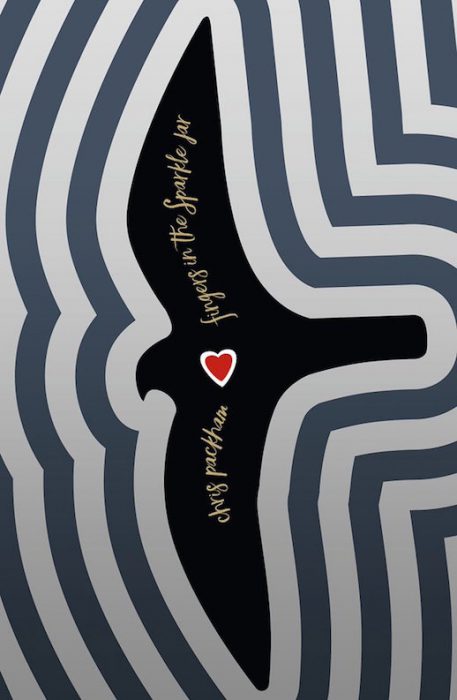Fingers In The Sparkle Jar by Chris Packham
Ebury Press, 276 pages, out 5 May 2016.
Review by Roy Wilkinson
Hail the evolution of the Packman. This now-notable presence was first broadcast to the wider world on the BBC’s The Really Wild Show in 1986 – his peroxide plumes teased into a plasti-punk pompadour modelled on Billy Idol. Chris’s seemingly focus-group-ed yoof-ness was accentuated by his place on the presenters’ sofa alongside the conspicuously non-styled Terry Nutkins. The latter’s fingers had been part-amputated by otters. Earthy or what?! Chris’s chirpy presence both engaged the kids and pulled in the traditional showbusiness entreaty of underwear-in-the-post, dispatched by engorged mums watching with their offspring. But it also pretty much pushed Chris into a gurning gnome grotto alongside Timmy Mallet. Now, however, this memoir seals Chris’s release from such glass-teat purgatory. It flies far above the merely wacky – brimming with brilliantly-charged recollection; childhood scintillae from a genuinely eccentric soul.
In 2016 Packham has long since revealed himself as a fascinating presence. The way he infiltrated song titles from The Smiths and the Manic Street Preachers onto Springwatch has become a pleasing kind of omni-knowledge – cheekily hinting at the counter-cultural hinterland that saw Chris hang-tough at Clash concerts in 1970s Southampton. (The internet also suggests there may have been Springwatch allusion to Coil’s 1986 12-inch The Anal Staircase. Could it be true?) But alongside becoming an assured TV face-of-nature, Chris has also revelled in embracing more contentious areas – out-and-proud defiance of the bozologists shotgunning hen harriers; cooly admonitory reminders of mankind’s collective population overload; appearing on Desert Island Discs and, in sombre style, explaining his decision not to father children, fearful of transmitting his own flawed make-up to future-time. Fingers In The Sparkle Jar gives the deep background to all the above – unpacking the Packham inner mind, from his origins in early-’60s Hampshire through to his discovery of punk in 1977.
It’s a sometimes odd book – and begins at its oddest. Chapters are short and date-stamped (July 1966… June 1976). The first few are in the third-person and a bit awkward – Packham portraying his five-year-old self as a mute Hants golem trying to buy an ice cream with a matchbox full of ladybirds. After 40 pages the narrative comes alive as it assumes the first-person voice that’s then maintained for the majority of the book. Dinosaurs, Marc Bolan, the Messerschmitt 262, Raquel Welch and repeat plays of The Damned’s New Rose all feature, but the backbone of the book is Chris’s hermetically close relationship with the kestrel he takes from a nest – a real-life manifestation of Kes. The film of Barry Hines’s book had become a UK nationwide sensation by the time Chris acquired his kestrel in 1975. But the gap between the average secondary-school egg-collector and Chris’s meticulous training of a falcon – complete with equipment mail-ordered from Pakistan – is vast. Here is an obsessive submersion in nature.
The book hinges on the way Packham conveys the delirious interior of this obsession – a whirling sense of wonder, as in the sweetly neurotic joy that arrives with his kestrel: “I felt like I’d climbed through a hole in heaven’s fence. I reeled through the night watching two, three, five and seven o’clock wind by on my Westclox and mapped the future of our lives in my head, planned everything and re-ran and re-imagined it until it was all absolutely perfect.” There’s a steady stream of striking description, as when birds’ wings “whirred liked shuffled cards”. The Sparkle Jar itself is something at once mundane and marvellous – an emotive peak in the story and one that’s best not revealed here, something that’s destroyed in a moment of casual schoolboy violence. Such rote oppression recurs through the book. The author is pretty much a ghost as school, a defenceless pariah, a “little spaz”.
Chris’s feverish immersion in flora and fauna is in no way limited to birds. At age 12 he’s climbing out his bedroom window to spend nights on a hillside watching foxes. There’s also the strange sensuality of his snake-collecting. “He wiped the residue of its excrement from its body,” he writes, slipping back into the third person. “The pungent fluid… was meant to deter predators. It didn’t deter him, he coveted the smell… At night he’d lie in bed waiting until the scent had faded from his nostrils before raising his fingers to sniff it again and again… Its tongue waved at him, forked and shivering… He drew its mouth up to his cheek… waiting until he felt the little lashes sticky lick and then to the tip of his nose and finally to his closed eyelid where he felt the tendrils touch in a delicate spidery kiss.”
Packham enters into an equally lyrical imagined intimacy with Anna, a porn model he finds in a discarded copy of Men Only. His connection with real girls – and humanity in general – is more frustrated. The author’s outsiderdom is recalled in the accounts of 21st-century therapy sessions that run through the book. This strand includes systematic recollection of an attempted suicide. What a waste that would have been – depriving us of someone who has become a valuable interventionist on behalf of the natural world and, now, with this book, someone whose writing takes us deliciously deep into the wonder of wonder.
